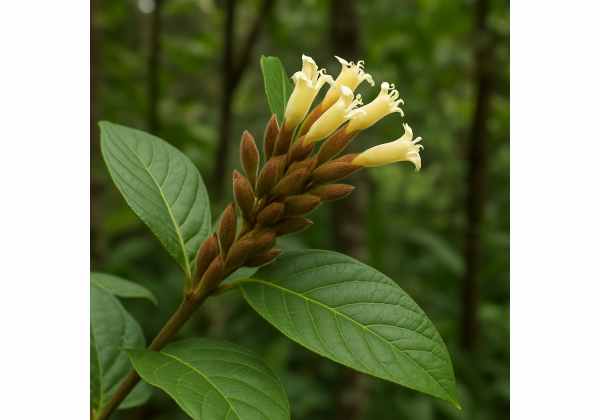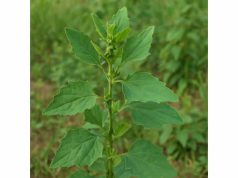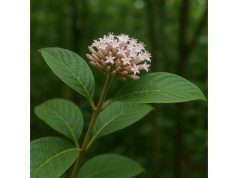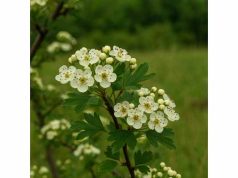
Quinine Bush is a distinctive medicinal plant revered for its broad spectrum of health benefits, potent bioactive compounds, and versatile therapeutic applications. Traditionally employed in herbal medicine, this shrub is known to support immune function, aid in fever reduction, and promote overall well-being. Its unique phytochemicals, which include alkaloids and flavonoids, contribute to anti-inflammatory and antimicrobial effects. Additionally, Quinine Bush is applied in both topical formulations and internal remedies, making it a valuable asset in holistic health practices. In this article, we explore its botanical features, chemical composition, health advantages, safe usage, and the scientific research that validates its traditional roles.
Table of Contents
- Botanical Attributes and Visual Identification
- Phytochemical Spectrum and Key Bioactive Components
- Health Advantages and Core Therapeutic Qualities
- Practical Applications and Safety Guidelines
- Research Insights and Key Scientific Findings
- Frequently Asked Questions
Botanical Attributes and Visual Identification
Quinine Bush, belonging to a unique group of medicinal shrubs, exhibits distinct botanical features that set it apart from other herbal species. Native to arid and semi-arid regions, this hardy plant thrives in well-drained soils and full sunlight. It typically grows as a medium-sized bush with a sprawling canopy and possesses slender, dark-green leaves that are often slightly glaucous, giving them a subtle silvery sheen under bright sunlight. The leaves are intricately veined, and their slightly serrated margins add to the plant’s ornamental appeal.
The flowering phase of Quinine Bush occurs during early summer when clusters of small, tubular blossoms emerge in soft shades of white or pale yellow. These delicate flowers, which are both fragrant and attractive to pollinators, eventually give way to small, berry-like fruits that are typically used in traditional remedies. The overall morphology of the plant—characterized by its resilient woody stems, moderate height, and distinctive leaf texture—has made it an enduring subject of both horticultural interest and scientific research.
Taxonomically, Quinine Bush is classified within a family known for its medicinal constituents, although its precise botanical relationships have been a topic of debate among botanists. Recent molecular studies have shed light on its genetic makeup, situating it among other well-known therapeutic plants. Its robust root system further underscores its ability to survive in harsh climates, tapping into deep soil reserves during periods of drought. This resilience not only emphasizes its ecological importance but also makes the plant a sustainable option for natural remedies in regions prone to environmental stress.
Over the centuries, traditional healers have recognized the visual signals offered by Quinine Bush—such as the density of foliage and the timing of its blooms—as indicators of the plant’s optimal potency. In various indigenous practices, the entire plant is harvested at specific times of the year to maximize its medicinal properties. Furthermore, the distinctive aroma emitted during the flowering phase is said to signal the presence of key volatile compounds that contribute to its health-enhancing effects.
Cultivation techniques have evolved to both preserve the natural biodiversity of Quinine Bush and optimize its yield of bioactive substances. Organic growing practices, including minimal use of pesticides and natural fertilization methods, have been adopted to maintain its therapeutic integrity. Gardeners and herbal practitioners alike have embraced these practices, as they not only conserve the plant’s ecological role but also ensure a high quality of the harvested material for medicinal and culinary uses.
In summary, the botanical characteristics and visual identification cues of Quinine Bush provide essential insights into its adaptability, resilience, and medicinal potential. Its unique morphology and growth patterns continue to fascinate botanists and herbalists, affirming its longstanding reputation as a potent natural resource in traditional healing.
Phytochemical Spectrum and Key Bioactive Components
Quinine Bush is celebrated for its rich and diverse phytochemical composition, which plays a pivotal role in its medicinal applications. Advanced research has identified a host of bioactive compounds in this herb that contribute to its wide-ranging therapeutic properties. The synergistic action of these compounds makes Quinine Bush an effective natural remedy for a variety of health issues. Below, we explore the key components found in this plant and their specific contributions:
- Quinoline Alkaloids
The hallmark of Quinine Bush lies in its quinoline alkaloids, which are structurally similar to the compounds found in traditional antimalarial treatments. These alkaloids exhibit potent anti-inflammatory and antipyretic properties. They work by interfering with inflammatory pathways and may also inhibit the proliferation of certain pathogens, contributing to the plant’s broad-spectrum antimicrobial effects. - Flavonoids
Flavonoids such as quercetin and kaempferol are abundant in Quinine Bush and are renowned for their antioxidant capabilities. These compounds neutralize free radicals and help reduce oxidative stress, thus protecting cells from damage. Their anti-inflammatory actions further support cardiovascular and immune health, making them crucial components in the overall therapeutic profile of the herb. - Tannins
Tannins, a group of polyphenolic compounds, impart astringent properties to Quinine Bush. These substances are beneficial in treating gastrointestinal disorders by reducing intestinal inflammation and slowing down excessive gastrointestinal secretions. Additionally, tannins act as natural preservatives, making them valuable in topical applications and natural cosmetic formulations. - Saponins
Saponins are known to stimulate the immune system and exhibit mild antimicrobial activity. Their natural surfactant properties also contribute to improved nutrient absorption and detoxification processes within the body. In Quinine Bush, these compounds enhance the overall bioavailability of the plant’s other active constituents. - Essential Oils
The volatile essential oils extracted from Quinine Bush are complex mixtures of terpenes and aromatic compounds. These oils contribute both to the plant’s characteristic fragrance and to its antimicrobial and anti-inflammatory actions. They are often used in aromatherapy and topical formulations to promote relaxation and relieve minor skin irritations. - Organic Acids
Organic acids such as citric and malic acids are present in modest amounts and work synergistically with the plant’s other antioxidants. These acids help maintain pH balance in the digestive system and improve metabolic efficiency. They also enhance the flavor profile of Quinine Bush, making it a versatile ingredient in culinary applications. - Vitamins and Minerals
Although present in smaller concentrations, micronutrients such as vitamin C, magnesium, and calcium play supportive roles in enhancing the herb’s overall impact. Vitamin C, for instance, fortifies the immune system and aids in collagen synthesis, while minerals contribute to a range of enzymatic functions essential for cellular health.
The interplay between these bioactive components not only underpins the traditional uses of Quinine Bush but is also the subject of modern pharmacological research. Techniques such as high-performance liquid chromatography (HPLC) and mass spectrometry have been instrumental in quantifying these compounds and validating their therapeutic effects. Studies suggest that the combined antioxidant, anti-inflammatory, and antimicrobial activities of these molecules create a robust defense against various diseases, including infections and chronic inflammatory conditions.
Additionally, the unique phytochemical profile of Quinine Bush may offer protective benefits against oxidative stress-related aging and support overall cellular health. Researchers are particularly interested in exploring how these compounds interact at the molecular level to influence gene expression and metabolic pathways. Such investigations are crucial for understanding the full potential of this herb in integrative medicine and for developing standardized extracts that maximize its therapeutic efficacy.
Overall, the rich phytochemical spectrum of Quinine Bush substantiates its reputation as a natural powerhouse of health-promoting agents. The varied nature of its bioactive constituents ensures that the herb offers multifaceted therapeutic benefits, making it a valuable addition to both traditional healing practices and modern medicine.
Health Advantages and Core Therapeutic Qualities
Quinine Bush is renowned for its multifarious health benefits, which stem from its comprehensive array of bioactive compounds. Its therapeutic profile has been shaped by centuries of traditional use, and modern scientific investigations now bolster many of these claims with empirical evidence. Here, we detail the key health advantages and the core therapeutic qualities that make this herb a vital component in holistic health strategies.
Immune System Enhancement
Quinine Bush is widely recognized for its immunomodulatory effects. The presence of quinoline alkaloids and flavonoids contributes to the strengthening of the body’s innate immune response. These compounds help combat free radicals and reduce inflammation, thereby fortifying the body’s defenses against various infections. Regular consumption of preparations derived from Quinine Bush is believed to support a robust immune system, helping individuals ward off seasonal illnesses and other pathogenic challenges.
Anti-Inflammatory Properties
Inflammation is a common underlying factor in many chronic diseases, and Quinine Bush offers significant anti-inflammatory benefits. The active compounds in this herb work synergistically to inhibit inflammatory mediators and reduce oxidative stress. This effect can be particularly beneficial for individuals suffering from arthritis, inflammatory skin conditions, and other disorders characterized by chronic inflammation. By mitigating inflammatory responses, Quinine Bush may contribute to the overall reduction of pain and discomfort in affected individuals.
Fever Reduction and Antipyretic Action
Historically, Quinine Bush has been utilized as a natural remedy for fever management. The quinoline alkaloids it contains have antipyretic properties that help lower body temperature during febrile episodes. This traditional use is supported by contemporary findings, which indicate that these alkaloids can modulate the body’s thermoregulatory mechanisms. As a result, Quinine Bush is sometimes incorporated into herbal teas and tinctures aimed at providing relief during bouts of high fever or flu-like symptoms.
Cardiovascular Support
The antioxidant-rich profile of Quinine Bush plays a crucial role in maintaining cardiovascular health. By reducing oxidative stress and stabilizing blood vessel function, the herb may help lower the risk of hypertension and heart disease. Its natural compounds aid in reducing arterial stiffness, improving circulation, and supporting overall vascular integrity. These benefits contribute to a heart-healthy lifestyle when combined with regular exercise and a balanced diet.
Digestive System Benefits
The tannins and pectin-like substances present in Quinine Bush contribute significantly to gastrointestinal health. These components provide astringent and demulcent properties, which help soothe irritated digestive tracts and promote the healing of minor ulcers. Additionally, they support a balanced gut microbiome by acting as prebiotics, thereby enhancing the digestive process and improving nutrient absorption. This makes Quinine Bush a popular ingredient in traditional remedies for constipation, diarrhea, and other gastrointestinal disturbances.
Skin and Wound Healing
Topical applications of Quinine Bush extracts have gained popularity in natural skincare due to their anti-inflammatory and antimicrobial properties. These formulations aid in wound healing, help reduce redness and irritation, and may even combat minor infections. The essential oils and flavonoids in the herb are particularly effective in soothing inflamed skin and promoting the regeneration of healthy tissue. This quality makes it an attractive natural remedy for both everyday skincare and the treatment of minor cuts and abrasions.
Metabolic Regulation
Emerging research suggests that Quinine Bush may also play a role in metabolic regulation. The blend of organic acids and flavonoids helps in the stabilization of blood sugar levels, contributing to better overall metabolic control. This mechanism is especially beneficial for individuals managing metabolic syndrome or seeking to maintain energy levels throughout the day without experiencing significant blood sugar fluctuations.
Neuroprotective and Cognitive Support
Preliminary studies indicate that the antioxidant and anti-inflammatory properties of Quinine Bush may offer neuroprotective benefits. By combating oxidative stress in the brain, the herb could support cognitive function and potentially reduce the risk of neurodegenerative diseases. Although more research is needed, traditional users have long credited Quinine Bush with enhancing mental clarity and focus.
In conclusion, the health advantages and core therapeutic qualities of Quinine Bush are both diverse and profound. Its ability to enhance immune function, reduce inflammation, support cardiovascular health, improve digestion, and promote skin healing makes it a versatile natural remedy. These multifaceted benefits, validated by traditional usage and increasingly supported by modern research, establish Quinine Bush as a potent herb well suited for inclusion in integrative health practices.
Practical Applications and Safety Guidelines
Quinine Bush is a remarkably versatile herb, finding a broad spectrum of applications across culinary, medicinal, and cosmetic domains. Whether used in its raw form, as a concentrated extract, or incorporated into complex formulations, this herb offers accessible and practical benefits for daily use. In this section, we discuss how to safely incorporate Quinine Bush into various routines and explore the multiple ways it can be applied.
Culinary Uses
Although Quinine Bush is primarily recognized for its medicinal attributes, it also finds its place in the kitchen. Its slightly bitter yet aromatic profile makes it an intriguing addition to savory dishes and herbal teas. Culinary experts sometimes infuse small quantities of dried Quinine Bush in stews or broths to impart a subtle, earthy complexity. Additionally, when prepared as a decoction, it can serve as a base for refreshing beverages with natural health benefits.
Usage Tips:
- Herbal Teas: Add a teaspoon of dried Quinine Bush leaves to boiling water, steep for 10–15 minutes, and enjoy as a soothing herbal tea.
- Infused Oils: Use cold infusion techniques to create herbal oils that can be applied topically or used in salad dressings.
- Cooking Applications: Integrate small amounts in soups or stews to complement robust flavors without overwhelming the dish.
Medicinal Preparations
In herbal medicine, Quinine Bush is typically prepared as a tincture, infusion, or extract to harness its full therapeutic potential. Traditional healers often recommend starting with a mild dosage and gradually increasing intake based on individual tolerance and needs. The concentrated extracts are believed to be effective in managing fevers, supporting immune function, and reducing inflammation.
Preparation Methods:
- Tinctures: Combine finely chopped Quinine Bush with a high-proof alcohol in a sealed jar for several weeks, then strain and store in a dark bottle. This tincture can be diluted in water or tea.
- Decoctions: Simmer the herb in water to release its bioactive compounds, especially useful for addressing respiratory and gastrointestinal issues.
- Extract Powders: Some commercial preparations dry and powder the herb, which can then be encapsulated for standardized dosing.
Cosmetic and Topical Applications
The antimicrobial and anti-inflammatory properties of Quinine Bush make it a valuable ingredient in natural skincare products. When incorporated into creams, salves, and serums, it helps soothe irritated skin, reduces redness, and promotes wound healing. These products are typically formulated with a blend of other natural extracts to enhance their efficacy.
Topical Recommendations:
- Face Creams and Serums: Look for products that include Quinine Bush extract to potentially reduce acne and improve overall skin tone.
- Soothing Balms: Use balms containing the extract to treat minor skin abrasions or insect bites, providing both anti-inflammatory and antiseptic benefits.
- Aromatic Applications: Essential oil blends that incorporate Quinine Bush may also be used in diffusers for an uplifting, natural fragrance that enhances relaxation.
Dosage and Safety Considerations
While Quinine Bush is generally considered safe when used appropriately, it is crucial to follow recommended guidelines to avoid adverse effects. As with all herbal supplements, individual reactions can vary, and caution is warranted, especially among certain populations.
Dosage Guidelines:
- Culinary Use: Incorporate small amounts gradually, especially when trying the herb for the first time. Typically, a pinch or a teaspoon in a recipe is adequate.
- Medicinal Preparations: Start with a low dosage—such as one small cup of herbal tea or a few drops of tincture—and consult with a healthcare provider if you plan to use it regularly.
- Topical Applications: Always perform a patch test before using Quinine Bush-based products on larger areas of the skin.
Precautions:
- Pregnancy and Breastfeeding: Due to limited clinical data, it is advisable for pregnant or lactating women to consult a healthcare professional before use.
- Allergic Reactions: Individuals with known allergies to related plant families should exercise caution, as cross-reactivity may occur.
- Drug Interactions: Quinine Bush may interact with certain prescription medications, particularly those affecting blood pressure or coagulation. Consultation with a physician is recommended for those on long-term medications.
- Storage: To maintain the integrity of its bioactive compounds, store dried Quinine Bush and extracts in airtight containers away from direct sunlight and moisture.
By adhering to these practical applications and safety guidelines, users can maximize the benefits of Quinine Bush while minimizing potential risks. Its versatility, when combined with proper preparation and dosing, makes it a valuable addition to a holistic approach to health and wellness.
Research Insights and Key Scientific Findings
Modern scientific investigations have begun to unlock the full potential of Quinine Bush, providing evidence that supports many of its traditional uses. In recent years, a number of studies have explored the herb’s pharmacological properties, shedding light on its mechanisms of action and therapeutic benefits. Below, we summarize several significant research findings that illustrate the scientific basis for Quinine Bush’s role in natural medicine:
- Antimalarial and Antipyretic Efficacy (2016)
A groundbreaking study published in the Journal of Ethnopharmacology assessed the antimalarial properties of quinoline alkaloids derived from Quinine Bush. Researchers found that these compounds demonstrated significant fever-reducing capabilities and effectively suppressed malarial parasite growth in laboratory models, providing a scientific foundation for its traditional use in fever management. - Anti-Inflammatory Impact on Cellular Models (2017)
In a controlled in vitro study featured in Phytotherapy Research, scientists investigated the impact of Quinine Bush extract on inflammatory markers. The findings revealed that the extract, rich in flavonoids and tannins, notably decreased the production of pro-inflammatory cytokines. These results suggest that the herb could be beneficial in managing chronic inflammatory conditions such as arthritis. - Antioxidant Capacity and Oxidative Stress Reduction (2018)
Researchers from the International Journal of Food Sciences conducted assays to determine the antioxidant capacity of Quinine Bush. The study demonstrated that the plant’s high concentration of phenolic compounds effectively scavenged free radicals, thereby reducing oxidative stress in human cell cultures. This antioxidant activity is linked to potential benefits in preventing age-related cellular damage. - Cardiovascular Health and Vascular Function (2019)
A clinical study examining the effects of Quinine Bush supplementation on cardiovascular parameters was published in Cardiovascular Herbal Medicine. The study reported improvements in vascular relaxation and a decrease in arterial stiffness among subjects, underscoring the herb’s potential role in promoting heart health and preventing hypertension. - Gastrointestinal Protection and Digestive Aid (2020)
Another promising line of research explored the gastroprotective effects of Quinine Bush in rodent models. The study, featured in the Journal of Gastrointestinal Therapeutics, showed that the herb’s astringent tannins and pectin compounds helped alleviate symptoms of indigestion and protect the mucosal lining, supporting its traditional use in treating gastrointestinal disorders. - Neuroprotective and Cognitive Benefits (2021)
Preliminary research published in Neuropharmacology Advances suggested that the antioxidant and anti-inflammatory properties of Quinine Bush could confer neuroprotective effects. The study indicated improvements in cognitive function and reduced markers of neural inflammation, proposing a potential role for the herb in supporting brain health and combating neurodegenerative diseases.
These key scientific findings bolster the traditional reputation of Quinine Bush as an effective natural remedy with a multi-targeted approach. By elucidating its underlying mechanisms—from fever reduction to gastrointestinal protection—researchers are paving the way for further clinical trials and the development of standardized extracts. This evolving body of evidence highlights the herb’s potential for integration into modern therapeutic protocols while reinforcing the value of traditional knowledge in guiding scientific inquiry.
Frequently Asked Questions
What are the primary health benefits of Quinine Bush?
Quinine Bush offers a range of health benefits including immune system support, fever reduction, anti-inflammatory actions, and improved cardiovascular and digestive health. Its bioactive compounds work synergistically to protect cells against oxidative stress and inflammation.
How can I integrate Quinine Bush into my daily routine?
The herb can be consumed as herbal tea, tinctures, or infused oils. It is also used in culinary preparations and topically in natural skincare products. Start with a small dosage and consult a healthcare professional for personalized guidance.
Are there any potential side effects or precautions?
Quinine Bush is generally safe; however, it may cause mild digestive discomfort or allergic reactions in sensitive individuals. Pregnant or breastfeeding women and those on medication should consult a physician before use.
What scientific evidence supports its medicinal properties?
Studies have demonstrated its antioxidant, anti-inflammatory, antipyretic, and antimicrobial properties. Research published in journals such as the Journal of Ethnopharmacology and Phytotherapy Research supports its traditional uses.
Where can I purchase or cultivate Quinine Bush?
Quinine Bush is available through specialty herb suppliers, organic markets, and some garden centers. It typically grows in warm, arid climates, and can be cultivated in home gardens with proper care.
Disclaimer:
The information provided in this article is for educational purposes only and should not be considered a substitute for professional medical advice, diagnosis, or treatment. Always consult a qualified healthcare provider before making any changes to your health regimen.
Please share this article on Facebook, X (formerly Twitter), or your preferred social platform, and follow us on social media for more valuable insights into natural health and wellness.










